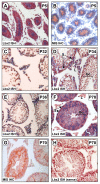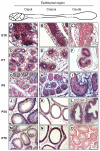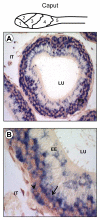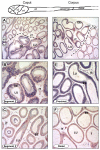Expression of the Ladybird-like homeobox 2 transcription factor in the developing mouse testis and epididymis
- PMID: 18304314
- PMCID: PMC2277406
- DOI: 10.1186/1471-213X-8-22
Expression of the Ladybird-like homeobox 2 transcription factor in the developing mouse testis and epididymis
Abstract
Background: Homeoproteins are a class of transcription factors that are well-known regulators of organogenesis and cell differentiation in numerous tissues, including the male reproductive system. Indeed, a handful of homeoproteins have so far been identified in the testis and epididymis where a few were shown to play important developmental roles. Through a degenerate PCR approach aimed at identifying novel homeoproteins expressed in the male reproductive system, we have detected several homeoproteins most of which had never been described before in this tissue. One of these homeoproteins is Ladybird-like homeobox 2 (Lbx2), a homeobox factor mostly known to be expressed in the nervous system.
Results: To better define the expression profile of Lbx2 in the male reproductive system, we have performed in situ hybridization throughout testicular and epididymal development and into adulthood. Lbx2 expression was also confirmed by real time RT-PCR in those tissues and in several testicular and epididymal cell lines. In the epididymis, a highly segmented tissue, Lbx2 shows a regionalized expression profile, being more expressed in proximal segments of the caput epididymis than any other segment. In the testis, we found that Lbx2 is constitutively expressed at high levels in Sertoli cells. In interstitial cells, Lbx2 is weakly expressed during fetal and early postnatal life, highly expressed around P32-P36, and absent in adult animals. Finally, Lbx2 can also be detected in a population of germ cells in adults.
Conclusion: Altogether, our data suggest that the homeoprotein Lbx2 might be involved in the regulation of male reproductive system development and cell differentiation as well as in male epididymal segmentation.
Figures









Similar articles
-
Expression of ladybird-like homeobox 2 (LBX2) during ovarian development and folliculogenesis in the mouse.J Mol Histol. 2010 Oct;41(4-5):289-94. doi: 10.1007/s10735-010-9291-5. Epub 2010 Sep 5. J Mol Histol. 2010. PMID: 20820887
-
Homeobox genes and male reproductive development.J Assist Reprod Genet. 1996 Feb;13(2):182-92. doi: 10.1007/BF02072542. J Assist Reprod Genet. 1996. PMID: 8688593 Review.
-
Pem: a testosterone- and LH-regulated homeobox gene expressed in mouse Sertoli cells and epididymis.Dev Biol. 1996 Nov 1;179(2):471-84. doi: 10.1006/dbio.1996.0276. Dev Biol. 1996. PMID: 8903361
-
Lbx2, a novel murine homeobox gene related to the Drosophila ladybird genes is expressed in the developing urogenital system, eye and brain.Mech Dev. 1999 Jun;84(1-2):181-4. doi: 10.1016/s0925-4773(99)00073-8. Mech Dev. 1999. PMID: 10473138
-
Identification of epididymis-specific transcripts in the mouse and rat by transcriptional profiling.Asian J Androl. 2007 Jul;9(4):522-7. doi: 10.1111/j.1745-7262.2007.00317.x. Asian J Androl. 2007. PMID: 17589790 Review.
Cited by
-
Evolution of lbx spinal cord expression and function.Evol Dev. 2021 Sep;23(5):404-422. doi: 10.1111/ede.12387. Epub 2021 Aug 19. Evol Dev. 2021. PMID: 34411410 Free PMC article.
-
Conservation of gene linkage in dispersed vertebrate NK homeobox clusters.Dev Genes Evol. 2009 Oct;219(9-10):481-96. doi: 10.1007/s00427-009-0311-y. Dev Genes Evol. 2009. PMID: 20112453
-
Is the Epididymis a Series of Organs Placed Side By Side?Biol Reprod. 2016 Jul;95(1):10. doi: 10.1095/biolreprod.116.138768. Epub 2016 Apr 27. Biol Reprod. 2016. PMID: 27122633 Free PMC article. Review.
-
The Rhox5 homeobox gene regulates the region-specific expression of its paralogs in the rodent epididymis.Biol Reprod. 2012 Jun 22;86(6):189. doi: 10.1095/biolreprod.112.099184. Print 2012 Jun. Biol Reprod. 2012. PMID: 22423045 Free PMC article.
-
Altered Expression of Candidate Genes in Mayer-Rokitansky-Küster-Hauser Syndrome May Influence Vaginal Keratinocytes Biology: A Focus on Protein Kinase X.Biology (Basel). 2021 May 21;10(6):450. doi: 10.3390/biology10060450. Biology (Basel). 2021. PMID: 34063745 Free PMC article.
References
-
- Bomgardner D, Hinton BT, Turner TT. Hox transcription factors may play a role in regulating segmental function of the adult epididymis. J Androl. 2001;22:527–531. - PubMed
Publication types
MeSH terms
Substances
LinkOut - more resources
Full Text Sources
Molecular Biology Databases
Research Materials

